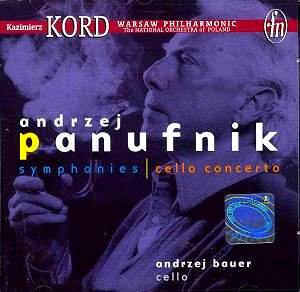Two
symphonies and a concerto by Panufnik. The concerto and the Tenth
Symphony are from Panufnik's last decade. The Sacra is
his most popular symphony and no wonder. With its accessible spirituality
and echoing gritty fanfares it instantly grips the attention.
The first part finds its cousin in such works as Gorecki's Third
Symphony and John Adams' The Wound Dresser. The fanfares
are distinctively Panufnik and are of a type also found in the
Heroic Overture and Tragic Overture.
The
Sinfonia Sacra bids fair alongside the two overtures
to be Panufnik’s most famous pieces - surely played more often
than his many other concert works. It is the epitome of Panufnik’s
cleanly antiphonal brass writing and his stunningly contrasted
prayerful writing for strings - in one long and sustained hushed
breath of prayer - like a yet more inward Tippett and Vaughan
Williams (Concerto for Double String Orchestra middle movement
against the spirituality of the Tallis Fantasia). Any new
recording has to contend with the composer’s ground breaking version
with the Monte Carlo Orchestra. This was made in 1961 originally
by Pathé-Marconi although its LP life was best known from
its appearance with the Rustica on a Unicorn LP then on
Unicorn CD UKCD 2020 in 1989. The composer’s other recording is
slightly quicker and for me does not have the same degree of inwardness
as the Unicorn or the Kord. This is on Nonesuch 7559-079228-2ZK.
The
CD Accord version has the inestimable advantage of modern sound
although the differences between the superb Unicorn sound from
almost forty years ago are nowhere near as divergent as you might
have guessed. The final hymn is extremely well done by Kord and
his Warsaw orchestra catching well the splintered quiet whistle
that was also used by Allan Pettersson in his extraordinary sorrowing
Seventh Symphony (still best experienced in the 1960s Dorati version
on Swedish Society Discofil) - beauty and sadness melting - separating,
resolving, sliding.
The
Cello Concerto was completed only days before Panufnik’s
death. It is typical of the composer with its long inward Adagio
followed by a flashingly active Vivace the whole lasting
less than twenty minutes. I was able to compare the first recording
which was on a NMC single (NMC D010S) with Rostropovich. The London
Symphony Orchestra is conducted by Hugh Wolff. That recording
was made at the Abbey Road studios on 25 June 1992 the day after
its premiere at the Barbican. And eight months after the composer’s
death. The vivace in the CD Accord version does not have
the hectic patter and tension of the Rostropovich version though
things are presented with a feeling of greater clarity. Overall
I have to favour the NMC version if you can find it though Andrzej
Bauer’s artistry is extremely sympathetic to the composer’s writing.
I
do not have a comparison for the Tenth Symphony in 1989-90.
This work plays for just under fifteen minutes with much brazen,
violent and vitriolic writing in which there is also some underpinning
of tragedy. This is Panufnik’s only untitled symphony and it is
his last. It was written for and premiered by Solti and the Chicago
orchestra. Rather like Havergal Brian’s 22nd Symphony Sinfonia
Brevis and Rubbra’s Eleventh this work repays repeated hearings.
Its warmly bathed eloquence and quiet rapture is best captured
through the very same long-breathed prayer of contentment that
sings with self-effacing reflection through the last four minutes
of the piece.
This
is an exultantly well planned and executed collection - generously
timed and most sensitively done. It would have been a world-beater
if only we could have had the Sinfonia Elegiaca rather
than the Concerto.
Rob
Barnett
MusicWeb
is now selling the CDAccord catalogue

![]() for
details
for
details